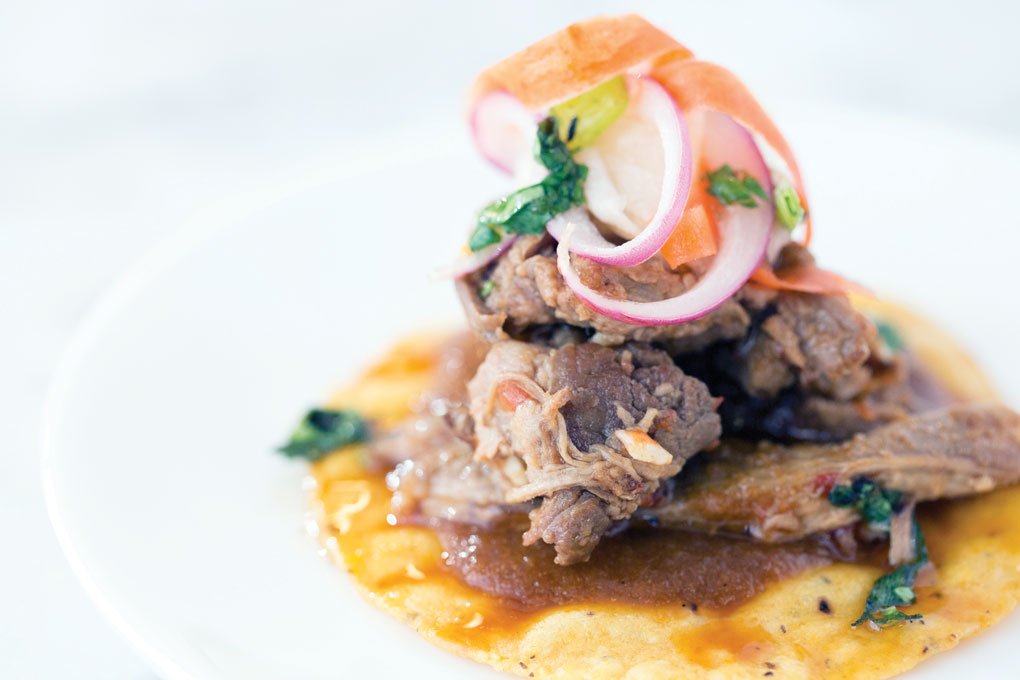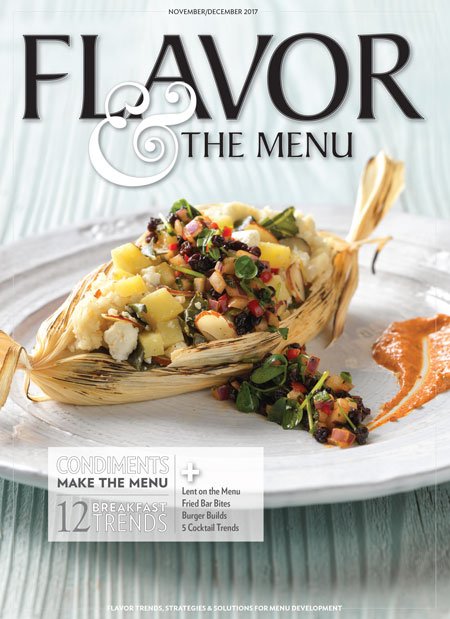Sambal is a sexy hot sauce. The name alone seduces with the promise of faraway adventure.
Hailing from Southeast Asia, it’s got seriously bright-hot heat with a magical combination of chile pepper, rice wine vinegar and citrus. But it also has just a touch of funk—a long finish with nuanced, deep flavor thanks to fish sauce and shrimp paste.
Knowing that the modern use of heat embraces this kind of multi-faceted personality, it’s no surprise that sambal is adding its flourish of heat to menus across the country.
Its use in dishes outside of authentic Southeast Asian food is also not a surprise, with today’s new American menus taking delight in pulling from the pantries of every nation that offers intriguing, bold, versatile flavors.
On the Menu
- Voodoo Pasta: Shrimp, andouille sausage, cavatappi noodles, yellow onion, green and red pepper, garlic, chile sambal sauce, Alfredo sauce, Parmesan, parsley
—Bar Louie, based in Addison, Texas - Braised Local Greens: Kale, collards, fatback, jowl bacon, onions, sambal
—Bacon Bros. Public House, Greenville, S.C. - Fried Chicken Bun with togarashi ranch, kimchi and honey sambal
—Linger, Denver - Ooey Gooey Fries: Beer-battered, with sour cream sambal, Monterey Jack and cheddar cheese, Cotija, chiles, cilantro and pickled garlic
—Chego, Los Angeles - Kimchi Burger with Muenster, bacon, sambal aïoli, cilantro
—Dark Horse Bar & Eatery, St. Paul, Minn. - Kizami Nori Salmon: Pan-seared Kizami nori-crusted salmon with crispy rice, sweet soy butter and sambal vinaigrette
—House of Blues, based in Los Angeles
Chefs Talk Sambal
Chefs are using sambal in fascinating ways, demonstrating how heat fits into so many of today’s applications—when applied with a deft, creative hand. It makes a bold counterpoint to sweet and savory, like in a sambal-honey glaze on wings or a sambal-spiked mayonnaise in a crispy fish sandwich. Wherever there’s a need for a distinctive, unexpected punch, sambal shines brightly.
“Our sambal slaw was conceived as a way to dress our honey and bourbon-smoked pork belly taco. The pork belly by itself is rich, fatty, smoky and sweet. As opposed to using a straight chile pepper hot sauce, the sambal oelek is a grind of chiles mixed with vinegar and tends to bring heat as well as depth of flavor. There is no added sugar, so the true flavor of the chiles seems to be more prevalent. Sambal is mixed into our lemon vinaigrette so the combination of heat and acidity functions to contrast nicely with the sweetness and fattiness of the pork belly. Added to a napa cabbage slaw with radishes, red onions and red and yellow peppers, the dressing imparts a level of heat from the sambal along with a brightness of flavor that truly complements the pork belly.”
Rick Stack, Executive Chef, Sourwood Café, Big Canoe, Ga.
“The Malaysian-style paste has been a staple in my pantry both personally and professionally for as far back as I can remember. Though, being one to tinker with authenticity and profiles, I wanted to test my own batch of sambal by highlighting Happy Quail Farm’s Jimmy Nardello peppers, fresh cayenne, piquillo peppers, habanero peppers, and my timeless love of Medjool dates with their malty sweetness. The nuances brought forward from the combination are juxtaposed with Indonesian long pepper and star anise, which plays on the stimulating peppery notes while lending to the surprising nutty and hop-forward mousse that fills our Kashmere Eggs at The Alembic.”
Rachel Aronow, Executive Chef, The Alembic, San Francisco
“Sambal is one of my favorite condiments to use in the kitchen. I make my own version with fresh ripe cayenne peppers and fresh habaneros. I grind them up with garlic, shallots, fish sauce, sea salt and organic apple cider vinegar. I make a couple gallons at a time and let it age in the walk-in. The longer it ages, the better.”
Gregg Wiele, Corporate Executive Chef, Patina Restaurant Group, Based in Los Angeles
“The sambal used in my Smoked Shrimp Chile Sambal accentuates the natural sweetness of the shrimp, and also adds a nice bite with a smoky finish. It reminds me of eating fresh from a fire pit at the beach. What I appreciate most about sambal is its complexity of flavor—it’s not just one- dimensional spicy, or hot-just-to-be-hot, but offers a whole orchestra of aromatics that play across your tongue.”
Dale Talde, Chef/Partner, Talde, Brooklyn, N.Y.











